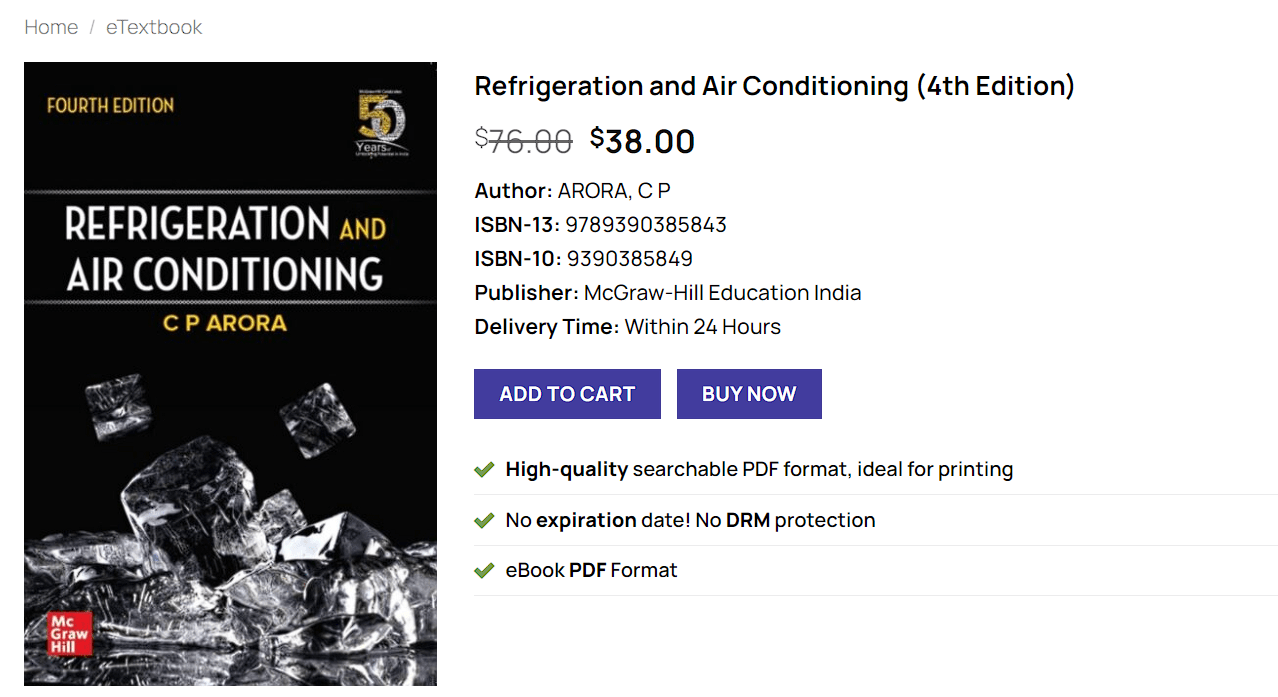Refrigeration and Air Conditioning 4th Edition textbook provides an extensive overview of the fundamental concepts and principles critical to the field. At the heart of refrigeration and air conditioning systems lies the refrigeration cycle, which consists of four key processes: evaporation, condensation, compression, and expansion. Understanding these processes is essential for grasping how these systems function to transfer heat efficiently.
In the refrigeration cycle, the evaporator absorbs heat from the space that needs to be cooled, causing the refrigerant to evaporate. This vaporized refrigerant is then compressed, increasing its pressure and temperature. The high-pressure vapor subsequently passes through the condenser, where it releases heat to the surroundings and condenses back into a liquid. Finally, the liquid refrigerant undergoes expansion, reducing its pressure and temperature before re-entering the evaporator to repeat the cycle.
Terminology such as refrigerants, heat transfer, and the classification of refrigeration systems is crucial for a comprehensive understanding. Refrigerants are the working fluids that undergo phase changes within the refrigeration cycle. The choice of refrigerant impacts system performance, efficiency, and environmental impact. Heat transfer, whether through conduction, convection, or radiation, is the core mechanism that allows refrigerants to absorb and release heat effectively.
Different types of refrigeration systems, such as vapor-compression and absorption systems, employ distinct methods for achieving cooling. Vapor-compression systems, the most common type, use mechanical energy to drive the refrigeration cycle. Absorption systems, on the other hand, utilize heat energy, making them suitable for scenarios where waste heat or renewable energy sources are available.
Energy efficiency and environmental considerations are increasingly important in modern refrigeration and air conditioning systems. The adoption of high-efficiency components and environmentally friendly refrigerants is essential to reduce energy consumption and minimize the ecological footprint. The principles outlined in the 4th edition emphasize the need for sustainable practices in designing and operating these systems.
Applications and Modern Advances in Refrigeration and Air Conditioning
Refrigeration and air conditioning systems play a critical role across a broad spectrum of industries, significantly impacting residential, commercial, and industrial sectors. In residential settings, air conditioning systems are essential for maintaining indoor comfort and air quality. Modern advancements such as smart thermostats have revolutionized home climate control, allowing homeowners to optimize temperature settings remotely and achieve substantial energy savings.
In commercial and industrial environments, refrigeration and air conditioning systems are indispensable for various applications, from food preservation and storage to maintaining optimal conditions for manufacturing processes. Supermarkets, for example, rely heavily on advanced refrigeration systems to keep perishable goods fresh. Meanwhile, data centers use sophisticated HVAC systems to manage the heat generated by high-performance servers, ensuring operational efficiency and preventing equipment failure.
Technological advancements have significantly enhanced the performance and sustainability of refrigeration and air conditioning systems. The development of environmentally friendly refrigerants, such as hydrofluoroolefins (HFOs), has addressed concerns related to ozone depletion and global warming potential. These refrigerants, combined with energy-efficient HVAC designs, contribute to reduced environmental impact and lower operational costs.
Another notable innovation is the integration of Internet of Things (IoT) technology in HVAC systems. Smart HVAC systems equipped with sensors and connectivity features enable real-time monitoring, predictive maintenance, and automated adjustments, enhancing both performance and user convenience. These systems not only improve energy efficiency but also extend the lifespan of the equipment by identifying and addressing potential issues before they escalate.
Proper maintenance and troubleshooting are crucial for ensuring the reliability and longevity of refrigeration and air conditioning systems. Regular inspections, cleaning, and timely repairs help prevent malfunctions and maintain optimal performance. Implementing a proactive maintenance strategy can significantly reduce downtime and increase the efficiency of these systems, ultimately leading to cost savings and enhanced user satisfaction.
In sum, the practical applications of Refrigeration and Air Conditioning 4th Edition and recent advancements in refrigeration and air conditioning underscore the importance of staying abreast of technological trends and maintaining rigorous upkeep practices. These systems are integral to modern life, and ongoing innovations continue to push the boundaries of efficiency, sustainability, and convenience.

